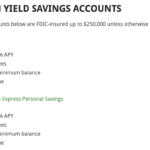Our High Yield Savings Account Deals Aren’t as Good as They Were a Week Ago – No Surprise There
Our high yield savings account deals aren’t as good as they were just a week ago.
Unfortunately, that is not a surprise.
What’s changed in that short amount of time?
Well, a lot, in the big picture.
But specific to being able to find a little bit of yield in a safe financial product, it was the Federal Reserve Bank dropping interest rates to essentially zero this past weekend.
To be completely transparent, the rate is always expressed as a range…in this case the range is 0% to 0.25%. But for all intents and purposes, the rate is zero.
Zero, nothing, nada…let that sink in for a minute.
This is only the second time EVER that the benchmark U.S. interest rate has hit the zero point. The other time was during the 2008 financial crisis.
For those unaware, the fed funds rate is used as a benchmark for both short-term lending for financial institutions and as a guidepost for many consumer rates.
Which is why the interest rate on many high yield products has dropped.
Savings Rates
We’ve written about SoFi and its SoFi Money product over the past months, which for a while was a really nice option for a variety of financial opportunities, earning an impressive 1.60% on deposited money being one.
Well, thanks to the Fed dropping interest rates, that nice yield is gone, replaced by a much more pedestrian 0.10% APY. Not much different than what you’ll find at your local brink and mortar financial institution.
And a number of the other high yield savings accounts we list on our High Yield Savings Accounts page have also reduced the rates they offer. You can still find some over 1%, but those likely will become less and less as our economic situation progresses.
I mention savings accounts because they are the safest option for putting money away for many Americans. High yield savings accounts offered the safety in conjunction with the ability to earn a little more interest on your savings.
Now, high yield rates are getting close to the “not worth it” range.
Other areas are affected by the fed funds rate, too.
Mortgages, Credit Cards and Loans
Mortgage rates, and the interest rates charged on credit cards, auto loans, personal loans and similar are also loosely tied to the rate set by the Federal Reserve.
Interestingly, many of those rates have not been as affected as we’ve seen the savings rates be.
That may change as time goes by, but if I had to guess, probably not. Banks, while structurally, from a financial perspective, sound, are not going to get out of the economic situation created by the coronavirus and subsequent stock market drop unscathed.
To keep balance sheets somewhat healthy, they’ll keep rates they charge to customers up, while lowering the rates they pay. See the high yield rates situation as an example.
That doesn’t mean there won’t be deals available, especially to customers with good credit.
It’s definitely worth watching mortgage interest rates in the coming weeks, and seriously considering re-financing if current rates are 0.75% less than what you’re paying.
That difference, even after factoring in the fees associated with a re-finance, could mean an extra $100, $200, or more in your pocket each month, depending on the amount of your mortgage.
Car loans are another place to compare interest rates. You may be able to lower your monthly payment by re-financing your auto loan to that lower rate.
So keep an eye out for opportunities, and strike on options that will better your financial position.
The Reason Rates are Zero
But keep in mind the reason rates are now at zero.
It’s because things are bad right now.
Coronavirus is spreading and we’re not sure how bad the impact will be on U.S. citizens.
In an effort to blunt as much as possible the virus’s effects, many parts of the economy have slowed considerably or shut down altogether.
The impact of which cannot be overstated. Many businesses will suffer financially, and others will simply close for good. And as a result, jobs will be lost and people will likely suffer.
Which is the primary reason interest rates have been cut to zero.
Significant monetary (Federal Reserve spending) and fiscal (government spending) policy will be implemented to help the businesses and individuals affected.
It won’t keep things as they were just a few months ago, but it will keep America from falling off a financial cliff.
A cliff on which the country is precariously standing right now.
So lots of money will be spent by governments at the zero interest rate level over the coming months.
Much needed money, to be sure.
But it shouldn’t be ignored that even at zero interest rate levels, this is debt, plain and simple. The government doesn’t really have this money just sitting around. So no matter what the final assistance number is, it will be added to the $23 trillion of debt America currently holds, with no idea how to control.
And its this level of debt that will cause economic problems down the road.
But, for now, that can’t be considered, we’ve got serious problems that need addressed, soon, to keep our country as stable as possible.
It’s going to be a difficult and nerve-wracking time over the coming months.
Keep your spirits up, stay healthy and watch for financial opportunities that may result from this current zero interest rate policy to help your bottom line now and in the future.
graph image courtesy of Idea go at freedigitalphotos.net



